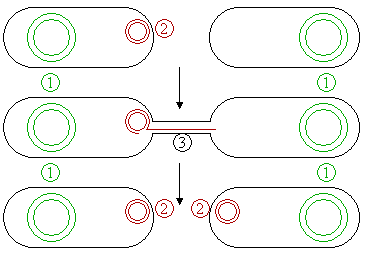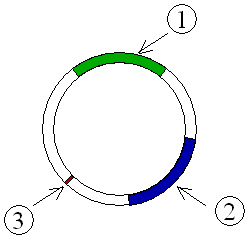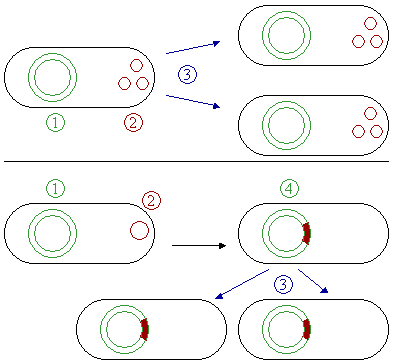Plasmid
|
|
Plasmids.png
Plasmids are (typically) circular double-stranded DNA molecules that are separate from the chromosomal DNA (Fig. 1). They usually occur in bacteria, sometimes in eukaryotic organisms (e.g., the 2-micrometre-ring in Saccharomyces cerevisiae). Their size varies from 1 to over 400 kilo base pairs (kbp). There are from one copy, for large plasmids, to hundreds of copies of the same plasmid present in a single cell.
| Contents |
Antibiotic resistance
Plasmid often contain genes or gene-cassettes that confer a selective advantage to the bacterium harboring them, e.g., the ability to build an antibiotic resistance. Every plasmid contains at least one DNA sequence that serves as an origin of replication or ori (a starting point for DNA replication), which enables the plasmid DNA to be duplicated independently from the chromosomal DNA (Fig. 2).
Episomes
Episomes are plasmids that can integrate themselves into the chromosomal DNA of the host organism (Fig. 3). For this reason, they can stay intact for a long time, be duplicated with every cell division of the host, and become a basic part of its genetic makeup.
Vectors
Genetically engineered plasmids are called vectors (or sometimes cassettes). They are used to transfer genes from one organism to another and typically contain a phenotypic genetic marker that can be selected for or against.
Types of plasmid
One way of grouping plasmids is by their ability to transfer to other bacteria. Conjugative plasmids contain so-called tra-genes, which perform the complex process of conjugation, the sexual transfer of plasmids to another bacterium (Fig. 4). Non-conjugative plasmids are incapable of initiating conjugation, hence they can only be transferred with the assistance of conjugative plasmids, by 'accident'. An intermediate class of plasmids are mobilisable, and carry only a subset of the genes required for transfer. These plasmids can 'parasitise' another plasmid, transferring at high frequency in the presence of a conjugative plasmid.

It is possible for several different types of plasmids to coexist in a single cell, e.g., seven different plasmids have been found in E. coli. On the other hand, related plasmids are often 'incompatible', resulting in the loss of one of them from the cell line. Therefore, plasmids can be assigned into incompatibility groups, depending on their ability to coexist in a single cell. These incompatibility groupings are due to the regulation of vital plasmid functions.
An obvious way of classifying plasmids is by function. There are five main classes:
- Fertility-(F)plasmids, which contain tra-genes. They are capable of conjugation.
- Resistance-(R)plasmids, which contain genes that can build a resistance against antibiotics or poisons. Historically known as R-factors, before the nature of plasmids was understood.
- Col-plasmids, which contain genes that code for (determine the production of) colicines, proteins that can kill other bacteria.
- Degrative plasmids, which enable the digestion of unusual substances, e.g., toluole or salicylic acid.
- Virulence plasmids, which turn the bacterium into a pathogen.
Plasmids can belong to more than one of these functional groups.
Plasmids that exist only as a single copy in each bacterium are, upon cell division, in danger of being lost in one of the segregating bacteria. Such single-copy plasmids have systems which attempt to actively distribute a copy to both daughter cells.
Some plasmids include an addiction system. They produce both a long-lived poison and its short-lived antidote. The cell that keeps a copy of the plasmid will survive, while the cell without the plasmid will die because it is running out of antidote shortly. This is an example of plasmids as selfish DNA.
Applications of plasmids
Plasmids serve as important tools in genetics and biochemistry labs, where they are commonly used to multiply (make many copies of) or express particular genes. There are many plasmids that are commercially available for such uses. Initially, the gene to be replicated is inserted in a plasmid . These plasmids contain, in addition to the inserted gene, one or more genes capable of providing antibiotic resistance to the bacteria that harbors them. The plasmids are next inserted into bacteria by a process called transformation, which are then grown on specific antibiotic(s). Bacteria which took up one or more copies of the plasmid then express (make protein) the gene that confers antibiotic resistance. This is typically a protein which can break down any antibiotics that would otherwise kill the cell. As a result, only the bacteria with antibiotic resistance can survive, the very same bacteria containing the genes to be replicated. The antibiotic(s) will, however, kill those bacteria that did not receive a plasmid, because they have no antibiotic resistance genes. In this way the antibiotic(s) acts as a filter selecting out only the modified bacteria. Now these bacteria can be grown in large amounts, harvested and lysed to isolate the plasmid of interest.
Another major use of plasmids is to make large amounts of proteins. In this case you grow the bacteria containing a plasmid harboring the gene of interest. Just as the bacteria produces proteins to confer its antibiotic resistance, it can also be induced to produce large amounts of proteins from the inserted gene. This is a cheap and easy way of mass-producing a gene or the protein it then codes for--for example, insulin or even antibiotics.
See also
da:Plasmid de:Plasmid es:Plásmido fr:Plasmide he:פלסמיד nl:Plasmide ja:プラスミド pl:Plazmid pt:Plasmídeo fi:Plasmidi


